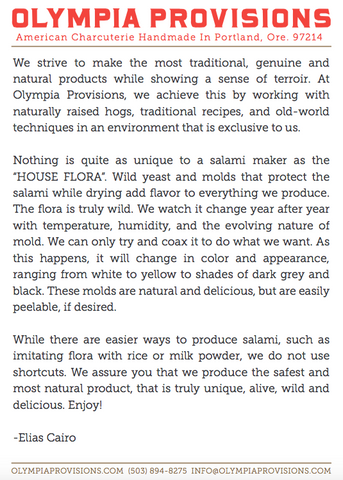Recipes
How do I store salami?
We suggest wrapping the salami loosely in its paper, placing it in a dry plastic bag (a produce bag from the grocery store works great) with the top folded over, but...
How do I serve salami?
A good rule for salami is to slice it cold and serve it at room temp. Slice it the thickness of a quarter on the bias for an impressive presentation.
How long does pâté last?
Once opened eat within 7 days. The rillettes are preserved in fat and can last much longer, use your judgement. Unopened the pate can be stored for about 2 weeks. ...
What preservatives are used in Olympia Provisions products?
Salami is preserved with the use of salt. Fresh sausages use a cultured dextrose and vinegar solution. We ONLY use natural preservatives.
Read MoreWhy does my Salami have an ammonia smell?
The natural molds of salami do create an off-gas that smells like ammonia. When the molds get warm, they off-gas more. If you open it up and let it breathe, the smell...
What are all the allergens in your products?
All allergens are listed on each ingredient statement. We have an allergen program that prevents cross contamination. Some products may contain: fish, dairy, gluten, eggs, and/or nuts. If you have specific...
Read MoreDo I need to refrigerate my salami?
Technically, no, but we do recommend it. Salami is shelf-stable, so it doesn’t require refrigeration, but it will continue to dry out and harden as it ages. For best results,...
How long will my salami last?
Salami stored in its original wrapping in the refrigerator will last up to 3 months. Salami will continue to harden and dry out as it ages, however it never "spoils"
Is my salami safe to eat if it is soft?
Yes. Our salamis are all tested to ensure that they are safe and ready to eat. Salami is a fermented product and meat is cured, not cooked. If you let...
Do I need to peel my salami?
Olympia Provisions uses all natural casings, so there is no need to peel the product. If you prefer the salami without the casing that is fine too!
What is that stuff on the outside of my salami?
That dusty stuff is a natural, edible mold similar to those found on aged soft cheeses. Its called Penicillium, and we inoculate our salami with it to help the aging...
What if my salami gets slimy or the mold isn't white?
If your salami gets slimy or their is a change in its appearance or smell, it is usually due to improper storage. Salami is a living product and needs to...


